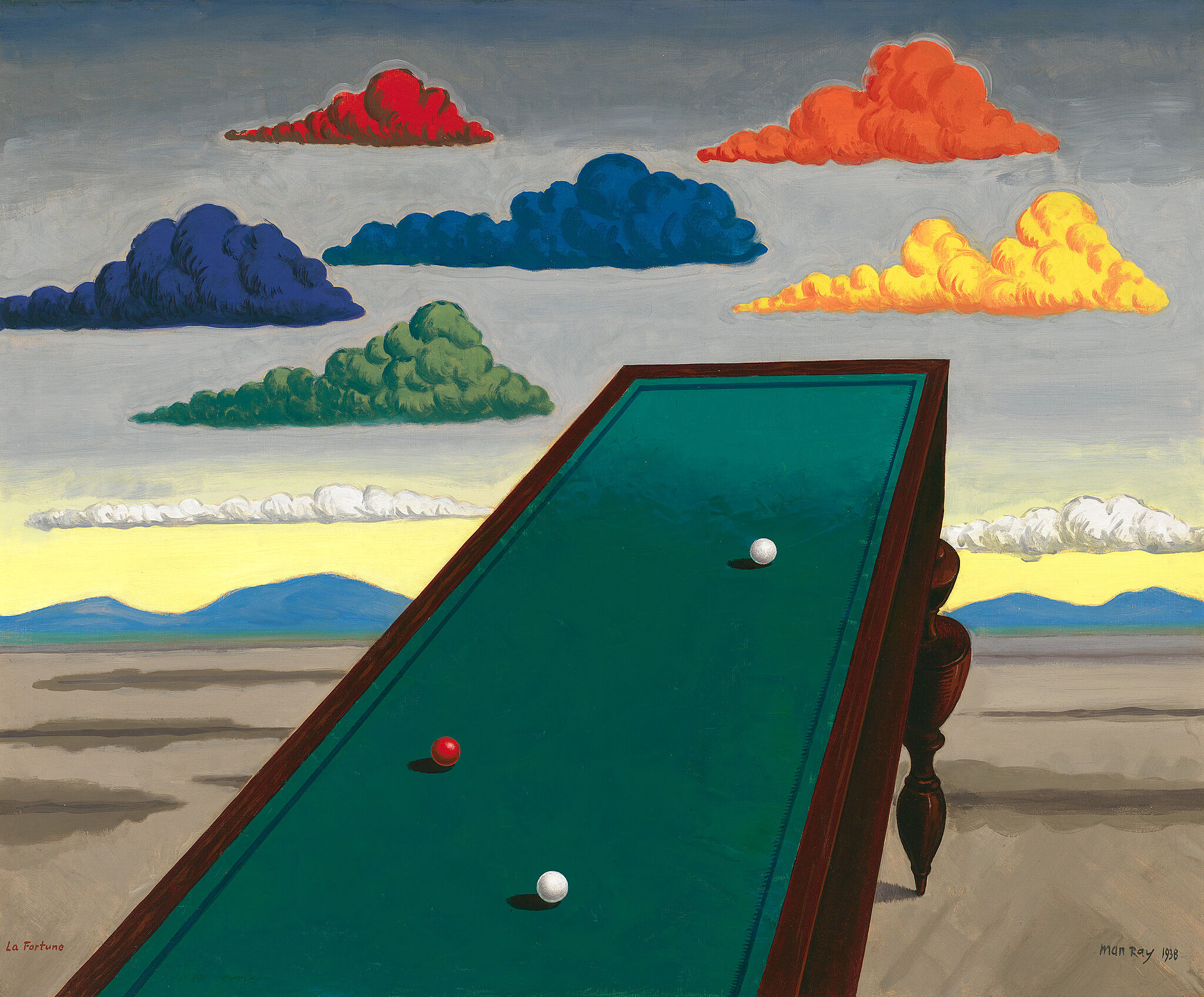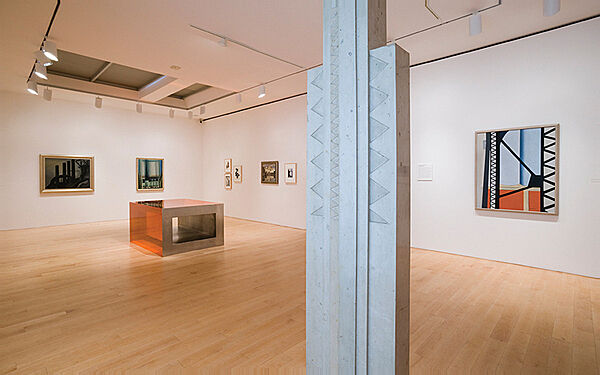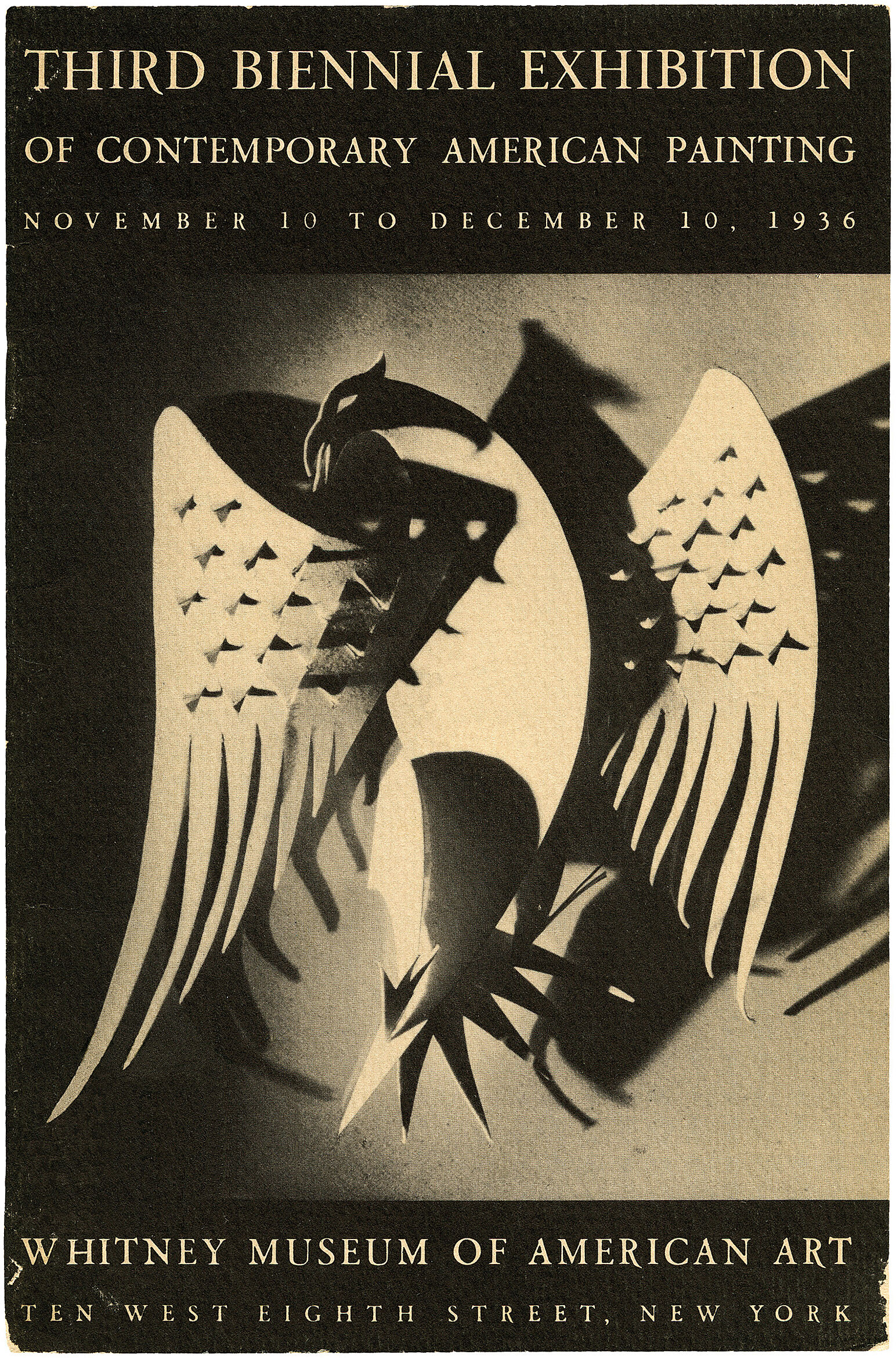Louis Guglielmi
1906–1956
Louis Guglielmi described Terror in Brooklyn, one of his best-known canvases, as “a premonition of war and tragedy.” The painting reflects the artist’s highly personal response to World War II and its impact on the American psyche. Guglielmi, who was born in Egypt to Italian parents and immigrated to the United States as a child, was one of a group of American painters who became known as the Social Surrealists. Along with artists such as Peter Blume and Walter Quirt, Guglielmi utilized the imagery and techniques of European Surrealism to address social and political themes during the 1930s and 1940s.
In Terror in Brooklyn Guglielmi envisions a foreboding scene. On a bleak urban street, three nuns are entrapped by a life-sized bell jar; they seem to cower in the presence of a bandaged pelvis that hangs, like a crucifix or relic, from a nearby building. Although painted in a meticulous realist style, the scene’s incongruous details—from the decapitated lamppost to the mirror reflection of the foreground scene in the background—evoke a disjunctive sense of reality. Wispy clouds streak across the sky, like the wake of aircraft, recalling the aerial blitz of London in 1940–41. The source for Guglielmi’s image was the intersection of Atlantic and East New York Avenues in Brooklyn, where buildings were being razed as part of an urban renewal project. The ruined buildings may have resembled photographs of the war’s devastation elsewhere, inspiring this enigmatic meditation on the looming threat of violence on American soil.
Introduction
Osvaldo Louis Guglielmi (April 9, 1906 – September 3, 1956) was an American painter. He was well known in New York, but soon forgotten after his death, as abstract expressionism came to overshadow artists like him. There are elements of precisionism, surrealism, geometric abstraction, regionalism, and social realism in his work. His paintings often commented on poverty and other social and political themes; bleakness and death appear regularly in his pre-war works. With Walter Quirt and James Guy, he was a prominent exponent of "social surrealism". After the war, his painting became more planar and abstract, with elements of cubism, and he disavowed the personal sadness in his earlier works in favor of expressing the "exuberance and organic means of life itself". The New York Times also attributed his decline to his being "a relentless borrower, an irrepressible eclectic who seemed to prey voraciously on the styles of others".
Born in Cairo, Egypt, as a child he lived in Milan and Geneva while his Italian father, a professional violinist, toured the world. In 1914 his parents brought him to the United States, where they lived in Italian Harlem, New York. He was interested in sculpture at a young age and worked at a casting factory. He attended the National Academy of Design in the evening beginning in 1920, while also attending high school, and attended full-time from 1923 to 1926. The next year he became a naturalized citizen. The Great Depression brought financial hardship, but the difficult times inspired his artwork. From 1935 to 1939, he worked with the Federal Art Project, which supported artists during the Depression. In the 1930s he spent many summers at the MacDowell Colony for artists in Peterborough, New Hampshire.
Guglielmi had his first one-man show in 1938, exhibiting his new work Mental Geography. Inspired by the Spanish Civil War—depicting a bombed-out Brooklyn Bridge—it was a warning that European fascism might spread. Guglielmi was part of the 1943 "American Realists and Magic Realists" exhibition at the Museum of Modern Art. He was with the Army Corps of Engineers in the war between 1943 and 1945, and did not paint. In the 1950s, he held positions at Louisiana State University, first as a visiting artist and then as an associate professor. He died in 1956 of a heart attack in Amagansett, New York.
Guglielmi's work is in the collection of the Art Institute of Chicago, the Detroit Institute of Arts, the Metropolitan Museum of Art, the Museum of Modern Art, the San Francisco Museum of Modern Art, the Smithsonian American Art Museum, and the Whitney Museum of American Art.
Wikidata identifier
Q2036288
Information from Wikipedia, made available under the Creative Commons Attribution-ShareAlike License . Accessed December 22, 2025.
Roles
Artist, illustrator, painter
ULAN identifier
500009048
Names
Osvaldo Louis Guglielmi, Louis Guglielmi, O. L. Guglielmi
Information from the Getty Research Institute's Union List of Artist Names ® (ULAN), made available under the ODC Attribution License. Accessed December 22, 2025.
























